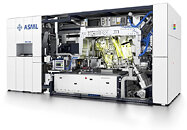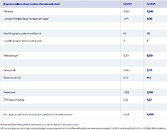- Joined
- Aug 19, 2017
- Messages
- 2,271 (0.92/day)
Today, ASML Holding NV (ASML) has published its 2021 third-quarter results. "Our third-quarter net sales came in at €5.2 billion with a gross margin of 51.7%, both within our guidance. Our third-quarter net bookings came in at €6.2 billion, including €2.9 billion from EUV systems. The demand continues to be high. The ongoing digital transformation and current chip shortage fuel the need to increase our capacity to meet the current and expected future demand for Memory and for all Logic nodes. ASML expects fourth-quarter net sales between €4.9 billion and €5.2 billion with a gross margin between 51% and 52%. ASML expects R&D costs of around €670 million and SG&A costs of around €195 million. For the full year, we are on track to achieving growth approaching 35%," said ASML President and Chief Executive Officer Peter Wennink.


Products and business highlights
Interim dividend and share buyback program update
The interim dividend for 2021 will be €1.80 per ordinary share. The ex-dividend date as well as the fixing date for the EUR/USD conversion will be November 2, 2021, and the record date will be November 3, 2021. The dividend will be made payable on November 12, 2021.
As part of its financial policy to return excess cash to its shareholders through growing annualized dividends and regularly timed share buybacks, ASML announced a new share buyback program which started on July 22, 2021, and is to be executed by December 31, 2023. As part of this program, ASML intends to repurchase shares up to an amount of €9 billion, of which we expect a total of up to 0.45 million shares will be used to cover employee share plans. ASML intends to cancel the remainder of the shares repurchased. In the third quarter, we purchased around €2.4 billion of shares under the current and previous program.
The share buyback program will be executed within the limitations of the existing authority granted by the Annual General Meeting of Shareholders (AGM) on April 29, 2021, and of the authority to be granted by future AGMs. The share buyback program may be suspended, modified or discontinued at any time. All transactions under this program will be published on ASML's website (www.asml.com/investors) on a weekly basis.
View at TechPowerUp Main Site


Products and business highlights
- In our EUV business, we had a record quarter in terms of shipments and revenue, due to the volume as well as the share of TWINSCAN NXE:3600D systems.
- The TWINSCAN NXE:3600D achieved a record of 160 wafers per hour at customers' sites.
- In our DUV business, we reached a milestone as we shipped the 1000th ArF immersion scanner. The first immersion system designed to support volume manufacturing, the XT:1700Fi, was shipped 15 years ago, in 2006.
- On October 19, 2021, we reached an agreement with Jenoptik AG whereby they will acquire the Medical Applications and Swiss Optic business of Berliner Glas. The deal is targeted to close by the end of the year, subject to regulatory approvals. This concludes our divestment plans regarding the non-semiconductor businesses of Berliner Glas. ASML acquired Berliner Glas in 2020.
Interim dividend and share buyback program update
The interim dividend for 2021 will be €1.80 per ordinary share. The ex-dividend date as well as the fixing date for the EUR/USD conversion will be November 2, 2021, and the record date will be November 3, 2021. The dividend will be made payable on November 12, 2021.
As part of its financial policy to return excess cash to its shareholders through growing annualized dividends and regularly timed share buybacks, ASML announced a new share buyback program which started on July 22, 2021, and is to be executed by December 31, 2023. As part of this program, ASML intends to repurchase shares up to an amount of €9 billion, of which we expect a total of up to 0.45 million shares will be used to cover employee share plans. ASML intends to cancel the remainder of the shares repurchased. In the third quarter, we purchased around €2.4 billion of shares under the current and previous program.
The share buyback program will be executed within the limitations of the existing authority granted by the Annual General Meeting of Shareholders (AGM) on April 29, 2021, and of the authority to be granted by future AGMs. The share buyback program may be suspended, modified or discontinued at any time. All transactions under this program will be published on ASML's website (www.asml.com/investors) on a weekly basis.
View at TechPowerUp Main Site





